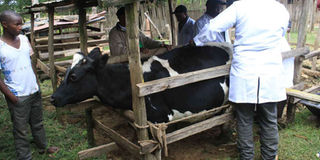Successful Artificial Insemination in Dairy Cows

Agricultural officials administer artificial insemination (A.I) to a dairy cow at a home at Endarasha in Nyeri. Timely A.I is important as delays in serving a dairy cow will reduce chances of conception as the ovum/egg ages or the spermatozoa may die. FILE PHOTO | NMG
What you need to know:
- A herd’s fertility is beneficial to the farmer as it affects the number of calves born, the amount milk produced, veterinary costs and ultimately the amount of money a farmer earns.
- Timely AI is important as delays in serving her will reduce chances of conception as the ovum/egg ages and/or the spermatozoa die.
- After insemination farmers should keep the semen straws for future reference to avoid inbreeding as bull/sire details are inscribed on them.
A dairy farm’s reproductive profitability is affected by accurate detection of heat and timely insemination of the cows.
These are the main factors that affect a dairy farm’s conception rates. A farmer’s ability to detect heat is crucial in the reproductive performance of a dairy farm as early or late insemination may lead to conception failure.
A herd’s fertility is beneficial to the farmer as it affects the number of calves born, the amount milk produced, veterinary costs and ultimately the amount of money a farmer earns.
Ordinarily a cow should calve once every twelve months.
Estrus cycle of dairy cows is between 18- 24 days with 21 days being the average. How then should a farmer know when a cow is on heat?
A cow on heat will have a drop in milk production, will appear restless and nervous, will bellow and have a clear discharge from her slightly swollen vulva; initially, the cow will mount other cows and will avoid being mounted cows but will later stand when mounted.
This is what is referred to as standing heat; if observed, this would be the perfect time to inseminate the cow.
Timely AI is important as delays in serving her will reduce chances of conception as the ovum/egg ages and/or the spermatozoa die.
It takes 12 hours for sperms to reach an ovum once inseminated and sperms have a lifespan of about 24hours inside the cow’s body.
The ovum has a lifespan of 6-12 hours from time of ovulation but is viable for fertilization for 8-10 hours. Ovulation occur 25-32hours after onset of heat.
If a farmer misses the standing heat sign then the AM-PM rule could be followed. If heat is observed early in the morning, then AI can be done late in the evening and vice versa.
There are several factors that affect the cow’s ability to show heat signs:
• Mineral deficiencies especially that of Phosphorus; Provide your cows with Intromin mineral blocks fed free choice.
• Poor body condition. Provide your cows with sufficient feeds
• A cow’s environment; cows in closed confinement may not show signs of heat.
Failures in conception in dairy cows are caused by among others:
• Poor semen handling and storage by inseminators; this affects sperm viability. Liquid nitrogen tanks should be tightly closed to prevent evaporation of the liquid nitrogen.
• Inexperienced inseminators.
• Poor heat detection because the farmer does not understand the signs of heat, or due to poor or no heat records; keeping records will help a farmer be able to almost predict when the next heat will occur.
• Cows with poor body condition caused by poor nutrition
• Uterine infection that may cause early embryonic deaths
• Hormonal imbalance
After insemination farmers should keep the semen straws for future reference to avoid inbreeding as bull/sire details are inscribed on them.
The straws will also provide records on a calf’s sire.
***
The writer is a Veterinary Surgeon and the Animal Health Manager at Elgon Kenya Ltd. Reach him through +254733715102 or e-mail him through [email protected]





